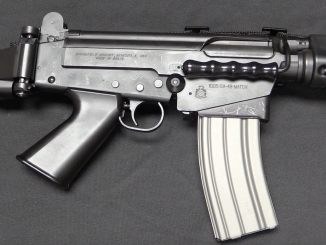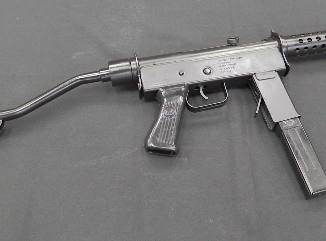Sold for $5,750 with four other rifles at the February 2020 RIA Sporting & Collectors auction.
In the aftermath of World War Two, Brazil decided to adopt a semiautomatic rifle for its military, in .30-06 caliber to fit logistically with the US. Curiously, they did not choose the M1 Garand, instead opting to begin domestic manufacture of a G43 copy in .30-06. The rifles were ready in 1954, made by the Fabrica de Itajubá in Minas Gerais. However, the guns had a lot of problems – not surprising when you look at the poor construction quality – and only about 300 were made before production was cut off. Ultimately the Brazilian military would continue using updated Mauser bolt actions in .30-06 (confusingly also designated M954) until adopted the FN FAL in 1964, built in the same Itajubá factory.




I have to wonder if the story behind Brazil’s decision to build a copy of the G43 was that they got given the equipment for the original G43 rifle line when the allies were dividing up Germany’s military assets after the war and adapted it to 30-06.
Good question. Would seem a lot easier just to keep the Garands they used in Italy. Already familiar, plenty of them around, could get them as US AID?
MG’s idea is the only thing that makes sense. Got the equipment as reparations, wanted to start their own line in a common caliber (assuming the MGs and other equipment was chambered in 30-06).
Very interesting. I wonder what was train of thought to adopt German based rifle. Why not allied M1 Garand? I suppose Ronaldo, if he shows up could give some background to that.
Rifle looks hefty, but as Ian said, bit crude in outer appearance. In any case, it is testimony to capabilities of Itajuba factory.
Have one and overall, you are right. It is a bit crude. Funny they followed the German standard of not finishing parts. Have not shot it (corona strikes) but own and have fired both the M1 and FN49. Both are much more polished.
Whoever said the 7MM is a good round is right. FN49 Sniper and it is very nice shooter.
Looking at the bolt, i wonder if they simply investment-cast and then milled it. I see a dead giveaway in the pores. And a casting mold is much easier to make than forging tools.
Would have made some sense in 7*57 mm Mauser. Best Mauser cartridge ever IMHO and Brazil had it in serice. Relatively easy conversion from 8*57. But in .30-06?? Wut?
In 1954 they tested also the SAFN in .30-06 and in 7,62×51. In 1956 they decided to buy the SAFN in .30-06 for their Navy (over 10.000 rifles).
The Força Expedicionária Brasileira fighting with the Allies in Italy and Getúltio Vargas’ wartime Estado Novo “second coming” as o pai do povo or “father of the poor” not whithstanding, the leadership of the Brazilian army during the 1930s was lily white–in a nation with a majority of persons of mixed race, albeit not so much in the south–and who were literally throwing parties and popping champagne corks in June 1940 because the “right side” was winning WWII…
.30-06 became the new service cartridge after WWII, but the rifle design selected was the FN-49 or SAFN, which laid the basis for the ultimate adoption of the FAL, built by Brazilian industry in Minas Gerais. One has to understand that building a domestic arms industry was long a goal for nationalists in general, and those very preoccupied with the “grandeza do Brasil” and its once and future status as a great power.
The Río de Janeiro Inter-American Treaty of Reciprocal Assistance:
https://en.wikipedia.org/wiki/Inter-American_Treaty_of_Reciprocal_Assistance
ensured that U.S. doctrine, weapons, training, etc. would be lavished on signatories, but many nationalists craved their own patterns, perhaps a bit like the Czechoslovaks within the Soviet sphere? In any case, the Río Treaty led to U.S. .30-06, and eventually 7.62x51mm becoming the standard service cartridges on a continent once ruled by 7x57mm and 7.65x53mm–at least with a few outliers like the brief and abortive 7x49mm liviano by Venezuela (replaced by 7.62x51mm), and by the late 1960s, Cuba (which went from .30-06 under U.S. auspices to 7.62x51mm, 7.62x45mm and 9-mm under the revolutionary regime and finally 7.62x39mm and 7.62x54Rmm by the late 1960s).
“(…) building a domestic arms industry(…)”
If I am not mistaken state of being import-independent is dubbed autarky by economic historians.
“(…)a bit like the Czechoslovaks within the Soviet sphere?(…)”
Similarity only superficial.
In these times Soviet Union keep own weapons often as secret as possible.
For example T-44 developed near end of Great Patriotic War:
https://tanks-encyclopedia.com/ww2/soviet/soviet_T-44.php
Throughout the Cold War, the T-44 was a very secret tank and was, therefore, never shown on military parades. Subsequently, there are supposedly no photos of East German T-44s, even though they were known to exist. It is known that T-44s were used in the Hungarian Uprising, 1956, and some photographs exist, although there is skepticism of their authenticity.
That also applied to 7,62×39 and 9×18 cartridge – were officially available to WarPact designer other than Soviet in mid-50s – that is why Czechoslovak used own cartridge in vz. 52 rifle. This secrecy led to Czechoslovakians to believe that 7,62×25 cartridge will stay for years to come and thus redesign their sub-machine gun from 9×19 to 7,62×25.
Some weapons factories active in Czechoslovakia (1918-1938) were founded yet in 19th century and procured weapons for Austria-Hungary, for example:
Skoda machine gun: http://hungariae.com/Skoda.htm
or
Schlanke Emma: https://www.militaryfactory.com/armor/detail.asp?armor_id=671
and soon after 1918 they offered weapons for exports, for example:
https://en.wikipedia.org/wiki/Skoda_houfnice_vz_14#Skoda_houfnice_vz_14/19
after 1945 there were gun designer who survived and could resume their works.
https://www.thefirearmblog.com/blog/2018/05/16/brazilian-g43-cloning-attempts/
Obrigado!
Muito obrigado, Ronaldo! I was aware of the Itajubá M.954, but not of that single (and unnamed) prototype made at the Arsenal de Guerra do Rio de Janeiro, which looks much more polished than the Itajubá effort (but of course, it is a prototype, probably hand-fitted).
One of the pictures in that blog entry seem to have been in http://claus.espeholt.dk/brazilian_g43.html for a while.
The M1 rifle, with seeming simplicity, is quite difficult to manufacture. There are many technological nuances, ignorance of which puts to make a quality rifle. And Americans are extremely reluctant to share relevant technologies…
The German rifle, on the contrary, was adapted for the production of wartime, by the hands of low-skilled workers with more productive technology. And much less demanding on the quality of the materials and equipment used.
German design, corny, simpler and cheaper.
I fully agree!
https://www.gunbroker.com/item/904705155